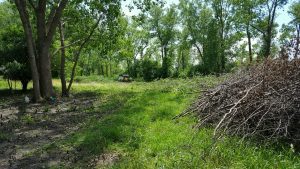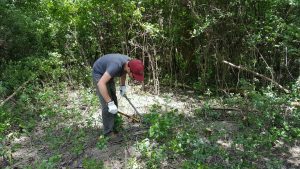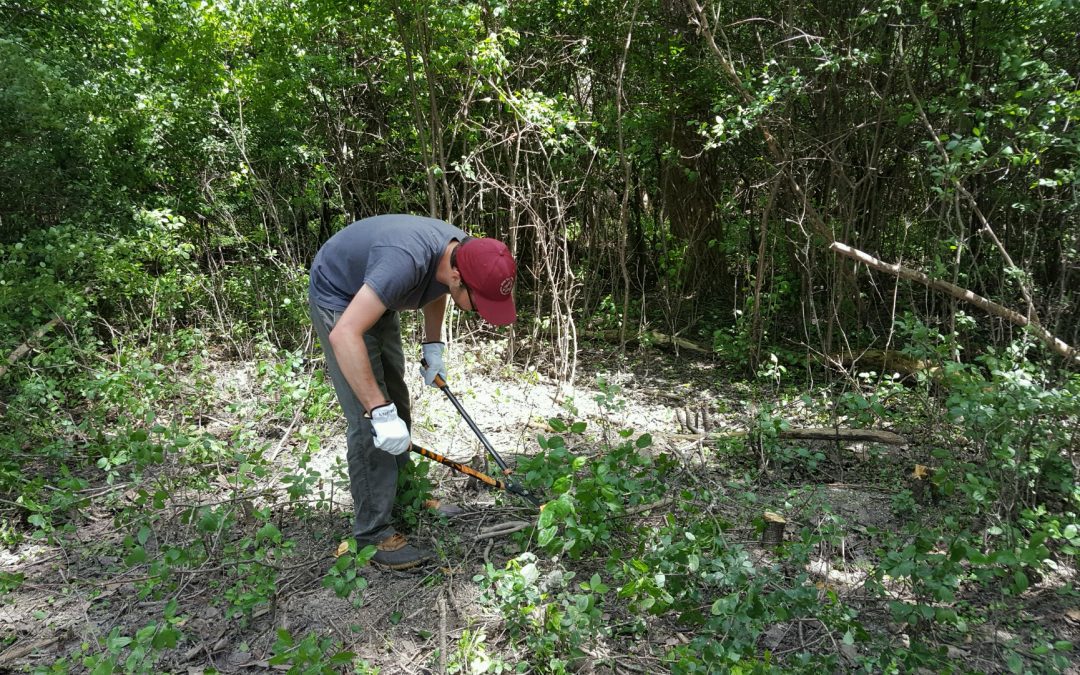
WNY PRISM Crew removing common buckthorn at Tifft Nature Preserve, as part of the vernal pool restoration project. Photo Credit: WNY PRISM.
Over the past several years, WNY PRISM has partnered with the Buffalo Museum of Science and Tifft Nature Preserve to help address the invasive species found in abundance on the preserve. Dedicated to conservation and environmental education, Tifft is a beautiful nature preserve containing hiking trails, idyllic fishing locations, important habitats for migratory birds, and various wetlands including vernal pools.
In 2017, WNY PRISM once again is working alongside Tifft Nature Preserve, this time on an ambitious vernal pool habitat restoration project. Vernal pools are small, seasonally flooded ephemeral wetlands, often occurring in forested ecosystems. Vernal pools are critical breeding habitats for amphibians, including blue spotted salamanders, which are listed as a “High Priority Species of Greatest Conservation Need” in New York State. In addition, vernal pools support large populations of invertebrates which are a major food source for many species of migratory birds.

Common buckthorn removal at Tifft Nature Preserve- area cleared is in the foreground with dense cover visible in the background. Photo Credit: WNY PRISM
The vernal pool habitat restoration project consists of two steps: upland habitat enhancement and wetland depression enhancement. This year, WNY PRISM and Tifft are focusing on the upland habitat aspect of the project which includes the removal of invasive species in buffer areas around the vernal pools. The WNY PRISM Crew, Tifft employees, and much appreciated volunteers, have spent a number of days cutting and stump treating common buckthorn (Rhamnus cathartica) with herbicide. Buckthorn is a woody shrub that forms dense thickets which prevent the regeneration of native tree, shrub and herbaceous species. The WNY PRISM Crew also treated small populations of common reed (Phragmites australis) and bohemian (hybrid) knotweed (Reynoutria bohemica) near the trails within the vernal pool area of the preserve. Invasive species removal is the first step in habitat restoration and the goal for these treatments is to reduce invasive species cover, prevent their further expansion, and prepare the site for native planting/restoration.

WNY PRISM Crew Member, Kevin Sander, cutting common buckthorn at Tifft Nature Preserve, as part of the vernal pool restoration project. Photo Credit: WNY PRISM
WNY PRISM will return to Tifft later this summer to continue efforts to manage invasive species at the preserve, particularly the high priority areas near the vernal pool sites and ponds at Tifft Nature Preserve. Next year, the focus will shift to the wetland depression enhancement aspect of the project, which will involve shallow excavation of the vernal pools and native plantings, including over 300 native trees.
This article was written by Heather Zimba, 2017 WNY PRISM Invasive Species Management Assistant.


